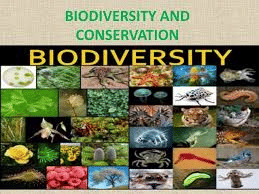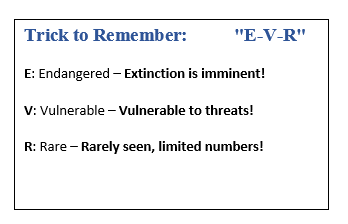Biodiversity & Conservation Class 11 Geography
Introduction to Biodiversity
Introduction to Biodiversity
- Geomorphic processes, particularly weathering, contribute to vegetation diversity and biodiversity.
- The weathering mantle is shaped by solar energy and water input, leading to variations in biodiversity.
- Biodiversity has evolved over 2.5-3.5 billion years, peaking before human impact.
- Human activities have accelerated species extinction.
- Current estimates suggest there are between 2 million to 100 million species, with about 10 million as a best guess.
- Tropical forests are particularly rich in biodiversity.
- Biodiversity is unevenly distributed, richer in tropical regions and declining towards the poles.
- The term "biodiversity" combines "bio" (life) and "diversity" (variety), encompassing all living organisms and ecosystems.

Biodiversity can be explored at three distinct levels:
1. Genetic Diversity
2. Species Diversity
3. Ecosystem Diversity

1. Genetic Diversity
- Genetic diversity refers to the variations of genes within a species.
- Genes are the fundamental building blocks of life forms, and variations within them are crucial for healthy breeding populations.
- For instance, while all humans belong to the species Homo sapiens, there are considerable differences in traits such as height, skin color, and appearance due to genetic diversity.
2. Species Diversity
- Species diversity relates to the variety of different species in a particular area.
- This diversity can be assessed by looking at the richness (number of species), abundance (population sizes), and types of species present.
- Some regions, known as biodiversity hotspots, are especially rich in species diversity, meaning they host a greater variety of species compared to other areas.
3. Ecosystem Diversity
- Ecosystem diversity encompasses the broad variations among different ecosystem types, including the range of habitats and ecological processes.
- The boundaries between ecosystems and communities (groups of interacting species) are often fluid and not strictly defined, making the classification of ecosystems complex.
Importance of Biodiversity
- Biodiversity has significantly influenced the development of human culture, while human communities have also shaped the diversity of nature at genetic, species, and ecological levels.
- It serves several important roles, including Ecological Role, Economic Role, Scientific Role.
Ecological Role of Biodiversity
- Various species capture and store energy, which is vital for sustaining life.
- Organisms produce and decompose organic materials, enriching the soil and supporting other life forms.
- Species facilitate the cycling of water and nutrients, ensuring resources are available for all living beings.
- Many organisms fix atmospheric gases, which helps maintain air quality and regulate climate.
Economic Role of Biodiversity
- Biodiversity is a vital resource for humans in daily life.
- Crop Diversity: Also known as agro-biodiversity, it is a significant aspect of biodiversity.
- Biodiversity serves as a reservoir of resources for:
(i) Food production
(ii) Pharmaceutical development
(iii) Cosmetic manufacturing - The exploitation of biological resources contributes to biodiversity loss. This exploitation has led to conflicts over the division and appropriation of natural resources.
- Key economic commodities provided by biodiversity include: Food Crops, Livestock, Forest products, Fish, Medicinal resources etc.
Scientific Role of Biodiversity
- Each species provides clues about the evolution of life and its future development.
- Biodiversity enhances our understanding of how life operates and the role each species plays in maintaining ecosystems, of which humans are a part.
- Every species, including humans, has a right to exist; it is ethically wrong to intentionally cause the extinction of any species.
- The level of biodiversity reflects our relationships with other living organisms.
- Biodiversity is a crucial aspect of many human cultures, emphasizing its broader significance beyond scientific understanding.
Loss of Biodiversity
- Increased human population has led to higher consumption of natural resources. This growth has accelerated species and habitat loss globally.
- Tropical areas cover about 25% of the world's surface but house roughly 75% of the human population.
- Over-exploitation and deforestation in these regions are rampant to meet population demands.
- Tropical rainforests contain 50% of Earth's species; their destruction threatens global biodiversity.
- Events like earthquakes, floods, volcanic eruptions, forest fires, and droughts adversely affect local flora and fauna.

- Pesticides and pollutants (e.g., hydrocarbons, toxic heavy metals) harm vulnerable species.
- Non-native species introduced to ecosystems can cause significant damage to local biotic communities.
- Species like tigers, elephants, rhinoceroses, and various birds have been heavily hunted for their body parts.
- This has led to many species becoming endangered.
- The International Union for Conservation of Nature (IUCN) categorizes threatened plant and animal species into three groups for conservation purposes.
Categories of Threatened Species
- Endangered Species: It encompasses species that face the risk of extinction. The IUCN releases global information on endangered species through the Red List of threatened species.
 Red Panda- an endangered species
Red Panda- an endangered species
- Vulnerable Species: This includes species that are at risk of extinction in the near future if the threats to their survival persist. Their survival is uncertain due to a significant decline in their populations.
- Rare Species: The populations of these species are quite small globally; they are restricted to specific regions or are sparsely distributed over larger areas.


Conservation of biodiversity
Conservation of biodiversity
- Biodiversity is crucial for human existence.
- All life forms are interlinked; disruption in one area can lead to imbalances in others.
- Endangered species can lead to environmental harm, threatening human survival.
- There is an urgent need to educate people on adopting eco-friendly practices.
- Activities should be realigned to ensure harmony with other life forms and sustainability.
- Effective conservation relies on the cooperation of local communities and individuals.
- Establishing local institutional structures is crucial for supporting conservation efforts.
- The focus should not just be on conserving species and habitats but also on ensuring the ongoing process of conservation.
 Humbodtia decurrens Bedd — highly rare endemic tree of Southern Western Ghats (India)
Humbodtia decurrens Bedd — highly rare endemic tree of Southern Western Ghats (India)
Biodiversity Conservation Strategies
- In June 1992, India joined 155 nations in signing this convention during the Earth Summit in Rio de Janeiro, Brazil.
- Actively protect species that are at risk of extinction.
- Develop effective planning and management strategies.
- Ensure the preservation of food crops, forage plants, timber trees, livestock and wild relatives of animals.
- Each country must recognize habitats of wild relatives and ensure their protection.
- Protect areas where species feed, breed, rest, and care for their young.
- Control trade in wild plants and animals to prevent exploitation.
- To safeguard, conserve, and promote species diversity within natural boundaries, the Government of India enacted the Wild Life (Protection) Act in 1972.
- This legislation led to the establishment of national parks, sanctuaries, and the declaration of biosphere reserves.
Biodiversity Hotspots
- Some tropical countries are rich in species diversity and are known as mega diversity centres.
- There are 12 such countries, Mexico, Columbia, Ecuador, Peru, Brazil, Democratic Republic of Congo, Madagascar, China, India, Malaysia, Indonesia and Australia.
- The International Union for the Conservation of Nature (IUCN) has identified specific areas as biodiversity hotspots to focus conservation efforts.
- Hotspots are defined based on their vegetation, which is crucial for ecosystem productivity.
- Plants are essential as they support the primary productivity of ecosystems.
- Most hotspots rely on species-rich ecosystems for resources like food, firewood, cropland, and timber income. Example - Madagascar:
- Approximately 85% of plants and animals in Madagascar are endemic, found nowhere else on Earth.
- Hotspots in affluent countries face various pressures, such as land development and invasive species.
- Hawaii, for instance, has many unique plants and animals threatened by introduced species and habitat loss.
|
70 videos|289 docs|44 tests
|
FAQs on Biodiversity & Conservation Class 11 Geography
| 1. What is biodiversity and why is it important? |  |
| 2. What are the main threats to biodiversity? |  |
| 3. How can we conserve biodiversity effectively? |  |
| 4. What role do protected areas play in biodiversity conservation? |  |
| 5. How does biodiversity contribute to human health and well-being? |  |






















